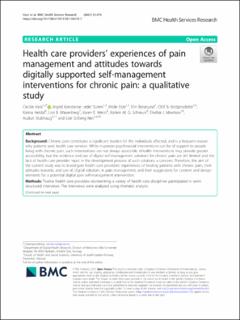| dc.contributor.author | Varsi, Cecilie | |
| dc.contributor.author | Solem, Ingrid Konstanse Ledel | |
| dc.contributor.author | Eide, Hilde | |
| dc.contributor.author | Børøsund, Elin | |
| dc.contributor.author | Kristjansdottir, Olöf Birna | |
| dc.contributor.author | Heldal, Karina | |
| dc.contributor.author | Waxenberg, Lori B. | |
| dc.contributor.author | Weiss, Karen E. | |
| dc.contributor.author | Schreurs, Karlein M.G. | |
| dc.contributor.author | Morrison, Eleshia J. | |
| dc.contributor.author | Stubhaug, Audun | |
| dc.contributor.author | Solberg Nes, Lise | |
| dc.date.accessioned | 2021-09-30T12:57:18Z | |
| dc.date.available | 2021-09-30T12:57:18Z | |
| dc.date.created | 2021-08-29T07:00:27Z | |
| dc.date.issued | 2021 | |
| dc.identifier.citation | Varsi, C., Ledel Solem, I. K., Eide, H., Børøsund, E., Kristjansdottir, O. B., Heldal, K., … Solberg Nes, L. (2021). Health care providers’ experiences of pain management and attitudes towards digitally supported self-management interventions for chronic pain: a qualitative study. BMC Health Services Research, 21, Artikkel 275. | en_US |
| dc.identifier.issn | 1472-6963 | |
| dc.identifier.uri | https://hdl.handle.net/11250/2786675 | |
| dc.description.abstract | Background: Chronic pain constitutes a significant burden for the individuals affected, and is a frequent reason why patients seek health care services. While in-person psychosocial interventions can be of support to people living with chronic pain, such interventions are not always accessible. eHealth interventions may provide greater accessibility, but the evidence and use of digital self-management solutions for chronic pain are still limited and the lack of health care provider input in the development process of such solutions a concern. Therefore, the aim of the current study was to investigate health care providers’ experiences of treating patients with chronic pain, their attitudes towards, and use of, digital solutions in pain management, and their suggestions for content and design elements for a potential digital pain self-management intervention.
Methods: Twelve health care providers representing a variety of health care disciplines participated in semi-structured interviews. The interviews were analyzed using thematic analysis.
Results: The material was analyzed into three main themes: [1] Patients with chronic pain and their current use of the health care services, [2] Health care providers’ own motivation and impression of patient prerequisites for use of digital self-management interventions, and [3] Suggestions for content and design elements in a digital self-management intervention for people living with chronic pain. The challenges faced by patients living with chronic pain were described as numerous. Despite interest and positive attitudes, few of the health care providers had used or recommended eHealth solutions to their patients. A range of potential content and functionality elements were identified, including aspects of motivation and engagement and providers also emphasized the importance of easy access and positive, personal content to support existing treatment.
Conclusions: This study offers insights into health care providers’ considerations for the potential of digital self-management interventions supporting patients living with chronic pain. Findings indicate the need for change and a more comprehensive treatment approach to pain management. eHealth solutions may contribute to such change, and providers pointed to a need for health care provider involvement, timely support and follow-up as important factors for integrating digital pain self-management interventions into clinical care. | en_US |
| dc.language.iso | eng | en_US |
| dc.rights | Navngivelse 4.0 Internasjonal | * |
| dc.rights.uri | http://creativecommons.org/licenses/by/4.0/deed.no | * |
| dc.title | Health care providers' experiences of pain management and attitudes towards digitally supported self-management interventions for chronic pain: a qualitative study | en_US |
| dc.type | Peer reviewed | en_US |
| dc.type | Journal article | en_US |
| dc.description.version | publishedVersion | en_US |
| dc.rights.holder | © The Author(s), 2021. | en_US |
| dc.source.volume | 21 | en_US |
| dc.source.journal | BMC Health Services Research | en_US |
| dc.identifier.doi | https://doi.org/10.1186/s12913-021-06278-7 | |
| dc.identifier.cristin | 1929500 | |
| dc.relation.project | Norges forskningsråd: 256574 | en_US |
| dc.source.articlenumber | 275 | en_US |
| cristin.ispublished | true | |
| cristin.fulltext | original | |
| cristin.qualitycode | 2 | |

